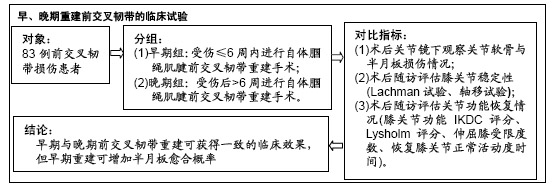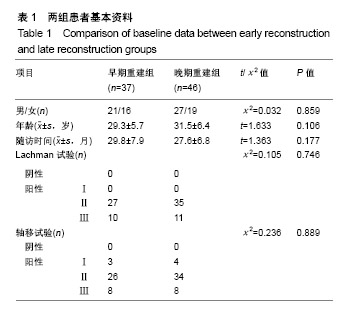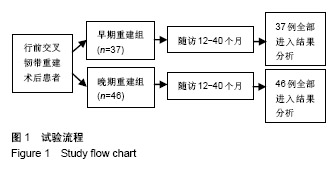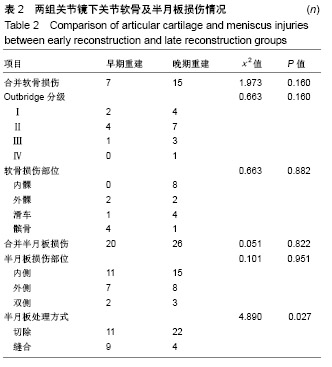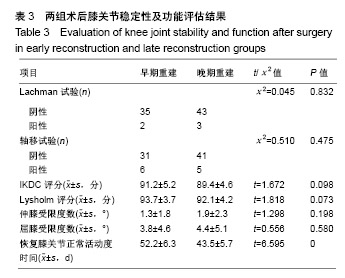| [1]Frobell RB,Roos EM,Roos HP,et al. A randomized trial of treatment for acute anterior cruciate ligament tears.N Engl J Med. 2010;363(4):331-342.[2]Brown CH Jr,Carson EW.Revision anterior cruciate ligament surgery.Clin Sports Med.1999;18(1):14-29.[3]Lee YS,Lee OS,Lee SH,et al.Effect of the Timing of Anterior Cruciate Ligament Reconstruction on Clinical and Stability Outcomes: A Systematic Review and Meta-analysis. Arthroscopy.2018;34(2):592-602. [4]Kennedy J, Jackson MP, O'Kelly P, Moran R.Timing of reconstruction of the anterior cruciate ligament in athletes and the incidence of secondary pathology within the knee.J Bone Joint Surg Br. 2010;3:362-366.[5]Frobell RB,Roos HP,Roos EM,et al.Treatment for acute anterior cruciate ligament tear:five year outcome of randomised trial.Br J Sports Med. 2015;49(10):700.[6]Sekir U,Gur H,Akova B.Early versus late start of isokinetic hamstring-strengthening exercise after anterior cruciate ligament reconstruction with patellar tendon graft.Am J Sports Med. 2010;38(3):492-500.[7]Krutsch W,Zellner J,Baumann F,et al.Timing of anterior cruciate ligament reconstruction within the first year after trauma and its influence on treatment of cartilage and meniscus pathology.Knee Surg Sports Traumatol Arthrosc. 2017;25:418-425.[8]Bottoni CR,Liddell TR,Trainor TJ,et al.Postoperative range of motion following anterior cruciate ligament reconstruction using autograft hamstrings: a prospective, randomized clinical trial of early versus delayed reconstructions.Am J Sports Med. 2008;36(4):656-662.[9]Christopher D,Hamer CD,Irrgang JJ,et al.Loss ofmotion after anterior cruciate ligament reconstruction.Am J Sports Med. 1992;5:499-506.[10]Cameron ML,Briggs KK,Steadman JR.Reproducibility and reliability of the outerbridge classification for grading chondral lesions of the knee arthroscopically. Am J Sports Med.2003;1: 83-86.[11]Hur CI, Song EK, Kim SK, et al. Early anterior cruciate ligament reconstruction can save meniscus without any complications.Indian J Orthop.2017;51(2):168-173.[12]Meighan AA,Keating JF,Will E.Outcome after reconstruction of the anterior cruciate ligament in athletic patients. A comparison of early versus delayed surgery. J Bone Joint Surg Br. 2003;85(4):521-524.[13]Angoules AG,Mavrogenis AF,Dimitriou R,et al.Knee proprioception following ACL reconstruction; a prospective trial comparing hamstrings with bone–patellar tendon–bone autograft.Knee.2011;18(2):76-82.[14]Brown CH, Spalding T, Robb C. Medialportal technique for single-bundle anatomical Anterior Cruciate Ligament (ACL) reconstruction. Int Orthop.2013; 37(2):253-269.[15]Lohmander LS,Englund PM,Dahl LL,et al.The long-term consequence of anterior cruciate ligament and meniscus injuries: osteoarthritis.Am J Sports Med.2007;10:1756-1769.[16]Oiestad BE, Engebretsen L, Storheim K,et al. Knee osteoarthritis after anterior cruciate ligament injury: a systematic review.Am J Sports Med. 2009;7:1434-1443.[17]Oiestad BE, Holm I,Aune AK,et al.Knee function and prevalence of knee osteoarthritis after anterior cruciate ligament reconstruction: a prospective study with 10 to 15 years offollow-up.Am J Sports Med. 2010;11:2201-2210.[18]Anderson AF. Correlation of Meniscal and Articular Cartilage Injuries in Children and Adolescents With Timing of Anterior Cruciate Ligament Reconstruction.Am J Sports Med. 2015; 43(2):275.[19]Andernord D,Karlsson J,Musahl V,et al.Timing of Surgery of the Anterior Cruciate Ligament.Arthroscopy. 2013;29(11): 1863-1871. [20]Bellabarba C,Bush-Joseph CA,Bach BR Jr.Patterns of meniscal injury in the anterior cruciate-deficient knee: a review of the literature. Am J Orthop (Belle Mead NJ). 1997;1:18-23.[21]de Roeck NJ,Lang-Stevenson A.Meniscal tears sustained awaiting anterior cruciate ligament reconstruction. Injury. 2003;5:343-345.[22]Stärke C,Kopf S,Petersen W,et al.Meniscal repair. Arthroscopy. 2009;9:1033-1044.[23]Bottoni CR,Liddell TR,Trainor TJ,et al. Postoperative range of motion following anterior cruciate ligament reconstruction using autograft hamstrings: a prospective, randomized clinical trial of early versus delayed reconstructions.Am J Sports Med. 2008;4:656-662.[24]Smith TO,Davies L,Hing CB.Early versus delayed surgery for anterior cruciate ligament reconstruction: a systematic review and meta-analysis.Knee Surg Sports Traumatol Arthrosc. 2010; 3:304-311. [25]杨国夫,宋国胜,李雪松,等.关节镜下早期重建与晚期重建前交叉韧带的近期临床疗效比较[J].中华创伤骨科杂志, 2010,12(4): 343-346.[26]李智尧,张磊.关节镜下前交叉韧带保残重建的研究现状[J].中国修复重建外科杂志,2010,24(3):304-308. |
